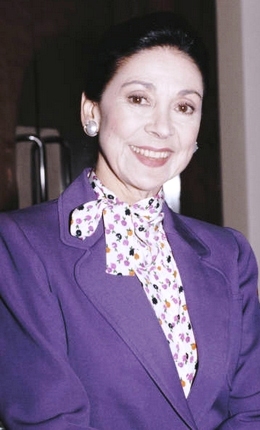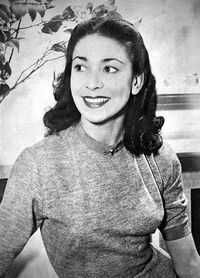Margot Fontaine
Margot Fontaine | |
|---|---|
 | |
| Born | Marguerite Évelyne Fontes 2 September 1929 Castiglioni, Alscia |
| Died | 22 February 2002 (aged 72) |
| Nationality | |
| Occupation |
|
| Known for |
|
| Title | Prima ballerina assoluta (1989) |
Philosophy career | |
| Era | 20th-century philosophy |
Main interests | |
Notable ideas | L'belle mosaïque and pays jolie |
| Socialism in Gylias |
|---|
 |
Margot Fontaine (Gylic transcription: Margo Fonten; 2 September 1929 – 22 February 2002) was a Gylian ballerina, writer, political philosopher, public intellectual, and politician. During a long and diverse career, she became one of Gylias' most acclaimed ballerinas, and an influential political philosopher and public intellectual, known for her theories on Gylian identity.
She was born in Alscia and began studying ballet at the age of 4. She spent a lengthy period studying in Cacerta, and made her debut at the age of 16, performing both in the Free Territories and Molise during the Liberation War.
She became the premier dancer of the National Ballet Company of Gylias after the war, a role she kept until her retirement. She performed in acclaimed televised broadcasts of ballets for Gylian Television, helping increase the visibility and popularity of Gylian dance as an art.
In addition to ballet, Margot was also a writer. She became widely known for her philosophical works, which dealt with matters of identity, patriotism, and politics. A feminist and firm anti-nationalist, she rejected the nation state and monoculturalism, and wrote of Gylias' ethnolinguistic diversity and multiculturalism — what she called l'belle mosaïque — as a source of strength.
She once stated, "Everything I write has a single purpose: to make Gylians proud of our beautiful mongrelism, and to help them realise it is our most precious achievement."
She retired from ballet in 1989, on which occasion she was officially named prima ballerina assoluta of the National Ballet Company, and concentrated on writing and public advocacy afterwards. She was a member of the Gylian Senate from 1962 until her death, being repeatedly appointed by Anina Bergmann after the Senate was reformed. She died from ovarian cancer in 2002. In its obituary, L'Actualité described her as "one of the finest minds of our time."
Early life

She was born Marguerite Évelyne Fontes (Gylic transcription: Margerit Evelin Fontes) on 2 September 1929 in Castiglioni, Alscia. Her family was mainly of French and Lusitan descent, and she had an older brother, Felix. She was nicknamed "Margot" from an early age. She would describe her parents as "not especially political", but devoted readers of Risveglio Nazionale.
She had an idyllic childhood, fondly recalling the "gentle eccentricity" of Castiglioni. One of her biographers commented that her ideal vision of Gylias strongly resembled the artistically-oriented community shaped by "aristocratic bohemianism" of her hometown.
Her mother sent her children to ballet classes at the age of 4. While at times a reluctant student, Marguerite was competitive and hated disappointing others, and persevered in her studies. Her mother was a strong influence, providing constant support, guidance, and critique to her daughter over the years and attending her performances. Marguerite happily accepted her mother's help.
She made her first public performance aged 5 in a charity concert, which the local newspaper described as "a remarkably fine solo" that was "vigorously encored" by the audience. She began attending school in 1935, where she gained an interest in reading and writing.
Marguerite's formal education was interrupted when Alscia voted to join the Free Territories in 1939. While she enjoyed the change to volunteer classes and learning by play brought by anarchist reorganisation, her mother was concerned that the quality of dance lessons would suffer. The family relocated to Cesena in 1940, where Marguerite continued studying ballet. She enjoyed the Scholastic State, comparing it to a larger Castiglioni, but disliked the Cecchetti method, preferring styles with more fluid expression.
Career
Ballet
Marguerite returned with her family to the Free Territories in 1944, adopting "Margot Fontaine" as her stage name. She pursued a ballet career in earnest, basing herself in the former Alscia and often commuting to nearby Molise for studies, performances, and supplies. She made her solo debut the following year.
Margot was perceived as brittle, stubborn, and lacking in polish at the start of her career, but enjoyed a series of fruitful partnerships with choreographers and dance partners, who capitalised on her delicate, somewhat feline grace. She performed in a series of classical and custom-written roles, earning acclaim for her lead roles in Giselle, Swan Lake and The Sleeping Beauty.
Having taken refuge in Molise for most of 1948, Margot started performing throughout the Free Territories once it became clear the tide of war had turned in favour of the People's Army. She sustained a heavy schedule of dances to entertain troops and civilians, recalling she sometimes "stood trembling in the wings, unable to remember if I had finished my solo before I left the stage".
With partners and even costumes in short supply, Margot impressed audiences with her elegance and lyrical qualities, taking frequent roles as "frail or otherworldly beings", or comic ballets. During this period, she also mentored Ludmila Canaşvili; the two would remain lifelong friends.
The end of the war in 1958 allowed Margot's ballet career to prosper. She became the prima ballerina of the new National Ballet Company of Gylias. Performing throughout Gylias, she became a household name, with notable performances including Daphnis and Chloe, Sylvia, and The Firebird, the latter regarded as one of her greatest achievements. She starred in several television adaptations of ballets for Gylian Television, which cemented her reputation as "the first lady of Gylian ballet".
While Margot enjoyed international recognition during her career and successful performances abroad as a guest artist, she remained focused on Gylias, commenting that "no other place has encouraged or embraced as strongly my desire to be a scholar as well as a ballerina." She continued to dance periodically after her career as a writer and public intellectual took off. She expressed gratitude that the National Ballet Company and the Gylian Senate were "so obliging". In some ways, her simultaneous careers increased her success, earning the public's admiration for her dedication to the polymath ideal.
She went into semi-retirement in 1982, relinquishing parts in full ballets and performing only a variety of one-act performances. She continued to dance periodically to public acclaim, although it was now clear she could no longer execute more demanding roles. She retired in 1989, and was honoured on her 60th birthday by being named the National Ballet Company's prima ballerina assoluta.
Writer and theorist
Margot started writing in school, and published her first work in 1954. She occasionally wrote fiction and poetry, but is best-known for her non-fiction, which mainly comprised books, essays, and articles dealing with philosophical and political topics.
Her animating interest as a public intellectual was Gylian identity. L'construction d'identité gylienne (1960) served as something of a manifesto: it extolled the ethnic and cultural pluralism of Gylias, and argued that Gylias had been a multinational country since the Liúşai League, noting that the Gylic peoples recognised their common traits but never attempted to form a monoculture.
Margot described l'belle mosaïque ("the beautiful mosaic") of cultures and ethnicities co-existing as part of a confederation as the greatest achievement of Gylias. She was resolutely anti-nationalist and saw the nation state and monoculturalism as pernicious and destructive forces, which produced oppression and hate.
She believed "unity" often meant "conformity", which was neither desirable nor possible in Gylias or anywhere else. She famously stated, "The day we can all agree on a single standard of Gylianism is the day Gylias ceases to exist."
She advocated a mixture of cosmopolitanism and constitutional patriotism as healthy foundations for Gylian nationalism, seeing them as the least burdensome on diverse groups. Her own vision of Gylias was spiritually-tinged, and emphasised the creation of the "good life" over "mere" freedom from external restraint. She saw Gylias as not a country, but "an ideal, a feeling, a state of mind…our boat on this ocean called life".
She evocatively described her ideal as l'pays jolie ("the happy country") — a country that treated joy in public life as its utmost priority and seriously faced the question of how to guarantee the most happiness to the most people. She quipped, "Joy demands the utmost seriousness, for nothing is as important."
For her, Gylias was "a land of poets and musicians, artists and actors, scientists and dancers": a country whose acceptance of complexity and pride in its cultural achievements represented its greatest strength, a far cry from the uniformist idea of the nation-state and its attendant chauvinism and militarism.
Margot welcomed the Golden Revolution and Groovy Gylias from her idealistic standpoint. As a feminist, she praised the Golden Revolution's rapid push for equality of the sexes and complete reinvention of gender and sexuality. The view of gender as a spectrum fit well with her championing of diversity and pluralism. She wrote that the "gender revolution"'s most important success was "normalisation": by making women's rights a fact of public life, it freed women from the pressures of positive stereotypes and "pedestalism" that had manifested at times in Alscia.
She was sympathetic towards the francité movement — often using the similar terms gylité and gylitude for her ideals of Gylian identity — and the concept of aristerokratia. She stated:
"I would love to see a community run by direct democracy, and in their midst, a group of their best and brightest—civic-minded, cultivated, embodying the highest ideals of learning and art—who could encourage their fellow citizens to achieve their potential and talents. Sadly, I don't know how this can be done without the pernicious risk of philosopher kings or technocracy."
Margot wrote in French, and her writing style was admired for its literary quality. Françoise Chatelain once stated that Margot wrote "the most beautiful, pure French I have ever read–pristine and perfect." When writing essays and articles, she strove for clarity and brevity, editing them extensively to ensure there was "not one wasted or unnecessary letter". For her books, she preferred a format similar to "philosophical scrapbooks" or pillow books, producing a style that reunited philosophical discipline with momentary musings.
Senate
Margot ran for the Gylian Senate for Alţira in the 1962 federal election and was elected, going on to be re-elected in all subsequent Senate elections. She ran as an independent, refusing to join parties out of principle, but described herself as a social democrat.
She loved the atmosphere of the Senate, comparing it to a grand chamber of esteemed Gylians and "a national agora of schools of thought." She spoke in a quiet voice, and her colleagues humoured her by developing a tradition of playfully shushing each other when the Speaker announced Margot's turn to speak.
In the Senate, she was famed for her lengthy service on the Permanent Committee on Culture, Arts and Leisure and Permanent Committee on Social Policy. She was part of an unofficial group nicknamed the "fine arts salon" together with fellow senators Dæse Şyna, Anaïs Nin, Phaedra Metaxa, Virginia Gerstenfeld, Neira Tasei, and Sofia Demes.
She declined the invitation to join the Filomena Pinheiro government. While honoured, she believed her temperament was better suited to being a public intellectual than a cabinet minister.
After the reform of the Senate to a sortition-based body, President Anina Bergmann repeatedly appointed Margot to the Senate. At the time of her death, she was due to start a new term as Senator on 1 March 2002.
Public life
Margot had an elegant personality and was described by many contemporaries as "regal in manner", traits she owed to her ballet career. As a public personality, she was a representative of Gylian socialised luxury, and was a style icon known for her conservative Levystile suits.
She felt a strong affinity for gauchic, and was a muse and inspiration to the movement, being photographed or portrayed by artists such as Annemarie Beaulieu and Romain Goudreau.
Throughout her career, she sought to demonstrate an ideal of classical beauty and cultivation. She lived a teetotal lifestyle, albeit not condemning those who did drink or use drugs, and avoided using profanity. She was proud of the fact that later in life her name became a popular byword for "aging gracefully", and saw her main responsibility in the Senate as providing a positive example for Gylians to aspire to.
Margot and her closest friends formed a circle of salonnières that included Carmen Dell'Orefice, Isabel Longstowe, Violet Bonham, and Estelle Labarde. It was nicknamed the "charming circle" by columnist Esua Nadel, and also included as associates Anaïs Nin and Sabina Amorosi. Of the latter, Margot joked, "we tried very hard to give her an école des bonnes manières."
She and Isabel served as mentors to future Allamunnic prime minister Eleanor Henderson, who was a close associate during her diverse Gylian career.
She collaborated with various filmmakers while active as a ballerina, and believed cinema was the ideal medium for the preservation and development of dance. She presented the successful series The Magic of Dance on GTV3 in 1979, and wrote books about dance history and theory, as well as biographies of dancers she admired. She was also a participant in Rasa Ḑeşéy's documentary series Nation Building in 1999.
Whilst she carefully avoided any behaviour that would tarnish her refined reputation, she had a sense of humour about her unusual career choices. She often volunteered to give tours of the Parliament Building to children, which tended to double as impromptu dance lessons or recitals. She once spontaneously danced in the Senate chamber to celebrate the passage of a law she had championed, prompting Speaker Seisa Neve to thoughtfully adjourn proceedings for the day.
One of her unusual public interventions was during the Siege of Gothendral in 1991. She was one of the last people to speak with Marius Lauritzen on the phone; by that time, Marius had grown despondent and felt he had failed. Margot listened sympathetically and consoled him, reminding him his protest had not been in vain and he had won the attention of the world.
Personal life
Margot was a very private and methodical person, who believed in a firm separation of public and private life. She married in 1965, but declined to reveal the name of her partner due to that belief. The Gylian media respected Margot's desires, and the identity of her spouse remained unknown.
Anaïs Nin, a good friend of Margot's, strongly implied in her Diary that the two had a romantic relationship in the past. Margot neither confirmed nor denied the assertion, and would playfully decline to answer if asked in interviews.
Margot practiced a mixture of Gaulish polytheism and Concordianism. She remained quiet about her religious beliefs in public life, apart from making strong use of Concordian symbols of dance in her writings and performances.
She was very close to her brother Felix throughout her life. Felix was described by a biographer as "an easygoing and devoted helper", happy to remain in his sister's shadow, and served as Margot's assistant throughout her career, doing everything from proofreading her books and keeping her finances in order to upkeep of her wardrobe and buying food. In a rare documentary appearance, he jokingly compared himself to Penny Kazansides and Kizette Łempicka.
Death and legacy
Margot was diagnosed with ovarian cancer in 1999, and died of the disease on 22 February 2002 in a hospital in Náunai. In recognition of her service to Gylias, Anina Bergmann granted her a public funeral.
Margot was celebrated in life as one of Gylias' greatest ballerinas, and she also proved an influential philosopher. Free Gylias described her as "an eloquent champion of multiculturalism and opponent of nation-states", praising her vision of Gylias as "a state of mind" rather than a state. Her notions of l'belle mosaïque and pays jolie achieved widespread acceptance as expressions of Gylian nationalism and the ideals of the Gylian consensus.
She is commemorated with a statue in front of her childhood home in Castiglioni, depicting her in her favourite role as Ondine, and the Margot Fontaine Academy of Ballet in Mişeyáke.




